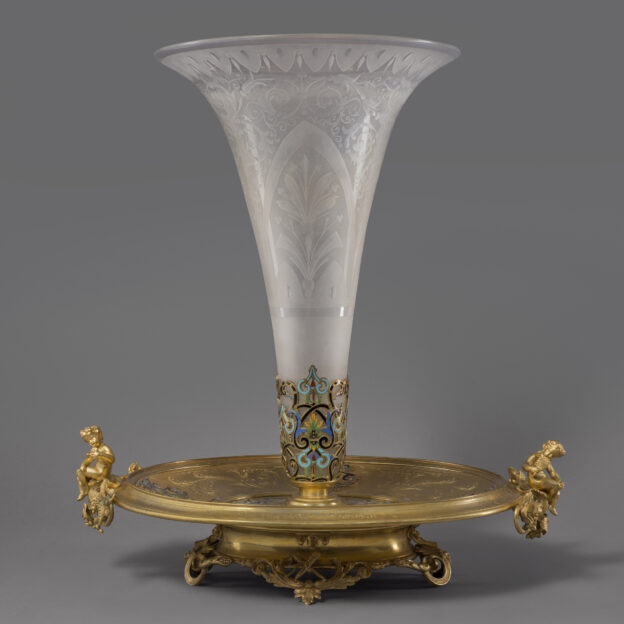Colin Et Cie.
A Louis XVI Style Gilt-Bronze and Sèvres Style Porcelain Mounted Figural Clock, Allegorical of the Arts
£13,500
A Louis XVI Style Gilt-Bronze and Sèvres Style Porcelain Mounted Figural Clock, Allegorical of the Arts. The dial signed 'Colin, Paris'. The movement...
Dimensions
Height: 47 cm (19 in)Width: 42 cm (17 in)
Depth: 19.5 cm (8 in)
Description
A Louis XVI Style Gilt-Bronze and Sèvres Style Porcelain Mounted Figural Clock, Allegorical of the Arts.
The dial signed ‘Colin, Paris’.
The movement stamped ‘Vincenti et Cie’.
The white enamel dial with Arabic numerals and five minute outer track, the twin train movement, striking on a bell .
This fine clock has a gilt-bronze case cast with a winged putto, allegorical of the arts and of paintin. He is holding a miniature portrait of a young lady, and leaning on a fluted half column beside a flambe urn on a foliate mounted moulded white marble plinth base and acanthus toupie feet
French, Circa 1890.
Vincenti et Cie
Vincenti was a much respected clock maker, a Corsican who set up in 1823 in Montbeliard using machinery of his own design.
Following his death in 1834 his business was carried on by Roux et Cie throughout the nineteenth century as Vincenti et Cie who were awarded the Médaille d’Argent in 1855.
Date
Circa 1890
Medium
Gilt-Bronze
Signature
The dial signed 'Colin | Paris'. The movement stamped 'Vincenti et Cie'.
Emile Colin was an independent foundry worker who, in the mid 19th century, worked for some of the best known sculptors in France, including Carrier-Belleuse, Pradier, Feuchère and Moreau.
In 1881, Emile Vie took over Gustave-Isaac Levy’s foundry and subsequently renamed it ‚‘E. Vie et Cie‚’. After several improvements and refurbishment’s tothe company, Vie died shortly thereafter at the beginning of 1882. At this point Emile Colin took over the company renaming it ‚‘E.Colin et Cie‚’.
Under Emile’s leadership the foundry was situated out of 29 Rue de Sevigné. Emile kept on many of the designs which were used before his appointment, but made sure the foundry was known for its speciality in producing statues. In 1898, Emile retired from his position and was replaced a member of his family. This resulted in a renaming of the company to ‚‘M.Colin et Cie‚’. Emile died one year later in 1899 from illness.
At the beginning of the century the firm had a large reputation for its lighting manufacture and ornate bronzes designed by various artists. A shop specifically for the sale of electric lighting opened in 1893 at 32 Rue du Faubourg-Saint-Honoré. However the company still made statues and objects which were sent to the 1893 Chicago Exposition and other exhibitions in Paris. In 1900, the company was awarded a prize at the 1900 Exposition Universelle after which they began to concentrate again on contemporary bronze works of art. In 1906, the company changed hands again until in 1923 it reverted to Ancienne Maison Colin. In 1939 the shop and its contents were abandoned.













 Print
Print


